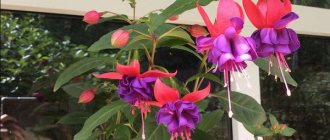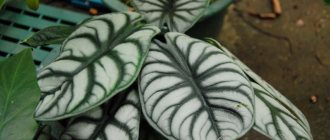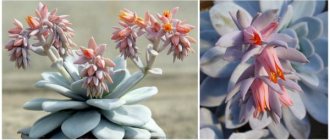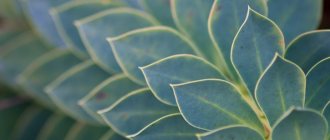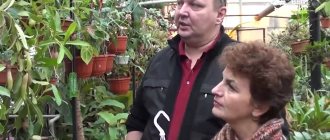More recently, coniferous plants were considered unsuitable for indoor culture. Now the opinion of flower growers has changed, and conifers, including cupressus, are grown indoors. Caring for cupressus at home is not difficult, it does not grow too quickly and is often used in the interior as a background for beautiful flowering plants.
In nature, cupressus are evergreen trees or shrubs, sometimes growing up to 40 m in height. Distributed in the tropics and subtropics of the northern hemisphere: in the Mediterranean, Crimea and the Black Sea coast of the Caucasus, off the southern edge of China, on the slopes of the Himalayas. Also found on the American continent from Oregon to Guatemala.
Decoration of your home - cypress Goldcrest Wilma
Cypress is a favorite of landscape designers and gardeners. It combines two advantages - aesthetic beauty and usefulness.
Before growing this plant, read the recommendations for caring for it.
Let's talk about Gold Wilma cypress: care at home, problems with growing, beneficial and harmful properties.
Reproduction
Amateur gardeners often purchase cypress seedlings in specialized stores. It is propagated mainly by breeders and people who grow the crop for sale. There are three propagation options: seeds, cuttings and layering.
Seeds
Propagation from seeds is used mainly in breeding work (for domestication of wild species). At home, it is possible to propagate cypress trees by seeds, but valuable varietal characteristics may be lost.
The first stage of propagation by seeds is the process of collecting seed material and properly drying it. To obtain uniform shoots, seed stratification is carried out (imitation of weather conditions). To do this, the seeds are sown in a moist soil substrate, after which the containers are taken outside and immersed in snow for the winter.
In the spring, they are brought into a warm place, waiting for germination, after which they provide abundant watering and, if necessary, dive. When the seedlings become stronger, they are taken out into fresh air for hardening. In April, with the onset of warmth, they are planted in open ground.
Cuttings
Cuttings are the most reliable method often used in home breeding. First, cuttings are prepared by cutting them from shoots 10 to 15 cm long (for columnar and spherical varieties, vertically growing stems are taken on the trunk, for creeping ones, lateral ones). The lower part is freed from the needles and planted in containers for rooting, having previously been dipped in a solution of a growth stimulator. Cover the top with plastic film, making it look like a greenhouse. High humidity promotes rapid rooting of cuttings.
After about 3 months, when small roots appear, remove the polyethylene and wait for the roots to develop. In 2 months they will reach a sufficient size and it will be possible to plant them in open ground. This must be done in the warm season, after hardening the plant.
Layerings
Reproduction by layering is possible if the cypress tree has creeping shoots. To do this, in the spring, choose the lower powerful stem. A shallow incision is made on it, into which a small pebble is placed, preventing it from overgrowing. The selected shoot is laid on the ground, fixed and the incision site is sprinkled with earth. Actively water it together with the parent plant. These actions help ensure that a young root system begins to develop at the incision site. Then the shoot is cut off from the tree, the young root is carefully dug out and transplanted to a permanent place before the beginning of the growing season.
Home care
This representative of evergreens and conifers takes root better than all others in apartment conditions. But he will not forgive you for inattention to himself !
How to care after purchase?
Cypress Goldcrest Wilma is very sensitive to external influences and lack of moisture . Do not loosen the soil under any circumstances to avoid damaging the roots.
Provide the plant with moderate air temperature in the remaining seasons of the year, and in winter – cool, 5 degrees.
From late spring to early autumn, it is better to place the cypress pot in fresh air, shading it and protecting it from drafts. The light should be bright and diffused. Do not destroy it with hot air from a radiator or heater during the rest period.
Features of watering
Water the plant on time. It is especially abundant from May to August inclusive. It is strictly forbidden to overdry it!
The reaction will occur only after some time - about a month. The cypress will turn pale, its branches will be dry and lifeless. But excess water is also harmful.
In winter , water several times a month at a temperature of 8-9 degrees, and once a week at 10-12.
Feel free to spray more often, maybe even daily.
Bloom
At home, Goldcrest Wilma cypress has almost no chance of blooming . This is due to the fact that unisexual male plants usually go on sale.
any big hits from him either. Cypress is dioecious in nature - for the formation of cones it is necessary to have both sexes of the plant - male and female.
Crown formation
By nature, Goldcrest Vilma is endowed with harmony and grace, correctness of form. First of all, this concerns the crown. It can be trimmed and adjusted occasionally. thorough pruning in the spring , before active sap flow begins.
It is useful to form a crown and trim it to give the plant a well-groomed appearance and activate the growth of young shoots. If you prefer classic forms, one procedure a year is enough. The tree will stretch upward, the growth of side shoots will remain slow, and the crown will form naturally.
If you wish, you can give the cypress an accent that is in tune with the overall interior of the home and your preferences. Fragile branches are easy to trim and “sculpting” the crown is not difficult. It’s quite easy to design the branches in the form of a cube, ball, pyramid, spiral to suit your imagination.
Preparing the soil and soil
Options:
- the pH level for soil for cultivation should be in the range of 5.5-6.5;
- a slightly acidic environment is most favorable;
- we select the soil in the ratio: one part turf soil, two parts leaf soil, one part peat soil and one part sand;
- We prepare high-quality drainage with the obligatory admixture of expanded clay, and make several holes at the bottom of the pot.
Planting and transplanting
If you want to plant a young sprout in a pot, do so when it reaches at least one month of age.
Do not immerse the root collar deep into the ground so that the plant does not die. The root collar is figuratively called the boundary that divides the trunk into aboveground and underground.
Growing
In open ground:
Light-loving species, for example, Cupressus macrofruit and Arizona, are planted in open places: they tolerate even direct sunlight well. Cupressus evergreen is shade-tolerant and does not require constant lighting.
Plants are undemanding to soil, but it is better if the soil is light, deep and fresh. Slightly acidic soils, with a pH of 5.0–6.0, or neutral ones, with a pH of 6.0–7.0, are preferred.
IN THE PHOTO: Most varieties of Cupressus are able to grow well in poor and rocky soils.
It is important to provide drainage to remove excess water from the area. If there is excess moisture in the soil, a tree or shrub dies due to root rot and windfalls. Cupressus, especially Lusitanian, does not benefit from excessive dry soil.
It is recommended to plant cupressus in early spring. For planting, a 1x1 m pit is dug. The soil at the bottom of the pit is loosened and sprinkled with pine humus. Sometimes the soil is completely replaced with a substrate of leaf soil, black soil, peat and sand in a ratio of 2:2:1:1.
The plant is placed in the planting hole so that the root collar is at ground level. Then the roots are sprinkled with earth or prepared substrate.
IN THE PHOTO: When planting a young tree, it is important to form a trunk circle. This will simplify watering, fertilizing and other care of Cupressus.
After planting, the plant is fixed with special braces and watered abundantly. In the future, street Cypress is watered exclusively during drought.
Fertilizing with universal fertilizer for coniferous plants is carried out annually. The amount and frequency of feeding is determined by the age and height of the Cupressus. The younger and shorter the tree, the more nutrients it will need and the more often it is fertilized. Fertilizers are applied to the tree trunk circle, with parallel loosening of the soil.
Foliar feeding will help to “revive” old Cupressuses or those growing on poor soil: the plants are sprayed with a solution of 1–2 g of nitrogen fertilizer in 1 liter. water.
In the container:
For Cupressus, a wide container 3–4 cm larger than the earthen ball with roots is suitable. It is filled with a ready-made substrate for indoor coniferous plants, or a 2:1:1 mixture of humus, leaf soil and sand. Coniferous soil, peat and perlite are added to the soil. Drainage is required.
The pot with Cupressus is placed in a lighted place, but not in direct sunlight. The contents are moderately warm, at +18–23°С. During the dormant period, in the winter months, the plant is kept at a temperature of +5–15°C.
IN THE PHOTO: A sufficient amount of diffused light is important for the decorative appearance of Cupressus needles.
Watering is moderate, when the top layer of soil dries. During the summer heat it is plentiful, in winter it is minimal to avoid drying out the soil.
For proper care of Cupressus, air humidity of at least 60% and ventilation all year round are essential.
It is fed with fertilizers with low phosphorus content, from spring to autumn, in small doses. The monthly amount of fertilizing according to the manufacturer's instructions is divided by the number of waterings, and is partially applied with each watering. During the dormant period, fertilizers are canceled.
Other recommendations for keeping Cupressus and other indoor conifers are set out in the publication: “Coniferous plants in the house - mission possible.”
Benefits and harms
There is a lot of talk about the beneficial and harmful properties of Goldcrest Wilma cypress. Let's start with the useful ones :
- extraction of essential oil used for aromatherapy, for respiratory diseases and for a beneficial effect on the female body, treating edema, normalizing mood and combating stress;
- tincture of cones is used in folk medicine for inflammatory processes and bleeding;
- needles have a good effect on the nervous system and the respiratory system, producing oxygen and harmonizing the microclimate in the house;
- The wood has a fungicidal effect - it repels small insects.
Scientific name
Cupressus Goldcrest Wilma is the scientific name for the type of cypress we are considering. The first word comes from the island of Cyprus, the birthplace of the evergreen plant. Its leaves are cross-paired - hence the second part of the name.
These photographs show all the beauty of this type of cypress.
Care and maintenance of Goldcrest Wilma cypress
The Goldcrest Wilma cypress has gained particular love among flower growers. In Latin, “cypress” sounds like “Cupressus”, that is, “kupressus”, therefore the use of both names is equally valid.
Indoor cypress was bred in Britain to be kept in offices, but quickly gained the love of gardeners around the world.
Cypress Goldcrest Wilma belongs to the cypress family and looks like a Christmas tree with narrow leaves, only in miniature. The shoots are light green, almost yellow, which is why this plant is sometimes called “golden”. The small scaly leaves emit a faint lemon aroma. The variety was bred on the islands of Foggy Albion specifically for indoor growing and became the most popular office plant there.
Care requirements
- Lighting. Cypress Goldcrest Wilma prefers indirect light. If there is too much light, it may crumble. In winter, if there is a lack of natural lighting, it is necessary to organize artificial lighting, since if there is a lack of light, the shoots will stretch out and the cypress will lose its decorative appearance.
- Temperature. Loves moderate temperatures. At temperatures above 27°C, the cypress will begin to dry out and crumble. In summer you can keep it outside, protecting it from the sun and drafts. In winter, the temperature should be approximately 8-10°C. Under no circumstances should you place a flower near batteries.
- Watering. In spring and autumn, cypress needs abundant watering. In winter, when the temperature drops, watering is reduced. Depending on the temperature conditions of the room, the plant’s soil should not be allowed to dry out or become waterlogged. Cypress naturally grows near bodies of water, so it prefers moist air. To do this, the tree must be sprayed regularly. If the plant is kept outside in the summer, then during the hottest days you can water it with warm water from a watering can several times a day.
- The soil. The easiest way is to purchase ready-made soil for coniferous plants. To prevent root rot, cypress requires good drainage.
- Feeding. Conventional complex fertilizers are not suitable for this plant. They might just burn the cypress. Therefore, in order not to take risks, it is better not to use any fertilizers.
- Transfer. Cypress Goldcrest Wilma is replanted only if there is a strong need in early spring. It has very delicate roots, and any replanting is stressful for the plant. If possible, you can simply replace the top layer of soil without damaging the root system. When replanting, the root collar should not be buried, otherwise the tree may die. In order to replant cypress as rarely as possible, some gardeners slow down its growth by pruning the roots during the next replanting.
- Trimming. To form a crown in the spring, cypress must be pruned. This procedure stimulates the development of new branches.
Transfer
Young plants are replanted annually in the spring, in April or May; older cypresses are replanted less frequently, as needed. Since the root system of cypress trees does not tolerate any interference, much less disturbance of the earthen coma, replanting is carried out using the transshipment method: in other words, only the soil that is shaken off from the roots of the plant removed from the old pot is replaced. The composition of the soil for cypress is approximately this: one part each of sand, peat and turf soil and two parts leaf soil. At the bottom of the pot, you first need to place a layer of drainage material a few centimeters deep, then a layer of fresh soil, on which the cypress root ball is installed, and then enough soil is added to the pot so that the pot is filled, but so that the root collar of the cypress remains above the ground.
Propagation of Goldcrest Wilma cypress by seeds and cuttings
Appearance of branches of plants of the cypress family.
- Use of seeds. This type of propagation is used in the spring, when the green cones have already opened. Up to 30 seeds ripen in each of them. They must be planted in a moist substrate and placed in a shaded place until germination. The germination rate of cypress seeds is very low. About 7-10 seeds will hatch from one cone. After the sprouts appear, the container must be moved to a lighted place. Caring for them involves moderate watering. After a month, young cypress trees can be planted in separate pots.
- Using cuttings. This method can be used in spring and autumn. To do this, it is necessary to cut off the lignified cuttings and root them in a moist substrate.
Cypress propagation
The crop can be propagated generatively by sowing seeds in the spring or vegetatively by cuttings. The second method is most often used. Cuttings taken at the transitional stage of foliage take root faster. The procedure can be carried out from mid-autumn to late spring.
For propagation, take 15 cm cuttings of the current season, woody at the base and green at the top; it is advisable to cut them with a “heel” or at an angle of 45 degrees.
Then the leaves are removed from the bottom of the cutting, as they may rot when planted in a damp substrate. Place a drainage layer of expanded clay in the pot and fill it with a mixture of peat moss and perlite (2:1) or universal soil with sand (2:1). Both mixtures are suitable.
When using a root growth stimulating hormone, first dip the tip of the cutting in water, blot thoroughly, dip the cut 5 cm into the powder, and then bury it in the prepared substrate.
The pots with cuttings are covered with a transparent bag, which will provide greenhouse conditions, and placed in a warm place (20-22 ̊C) in bright, diffused sunlight.
Check the soil regularly - it should always be moderately moist. Once a week, to prevent the appearance of mold and other fungal diseases, water with water containing a fungicide. Once every 2-3 days, the leaves are lightly sprayed with rain or melt water at room temperature.
The rooting process usually takes 3 months, but sometimes this period is longer. If there are signs of development of the root system, then the package is removed, and the seedlings will be ready for planting after another 2 months, when the roots are already visible from the drainage holes.
In any case, transplanting a cypress tree into open ground is carried out in warm weather after an adaptation period - take the pot out into the open air and place it in the shade for several days, then in partial shade, and so on.
Growing from seeds
After collection, the shifts are given a “wintering” - stratification. To do this, they are kept in the refrigerator for several months, then soaked before planting.
Sowing is done in a special soil mixture for conifers. Shoots appear in a month. Since the seedlings grow slowly, for the first 1 - 3 years they are grown at home, like an indoor flower. For the winter, it is advisable to arrange a “wintering”, maintaining a cool air temperature.
Cuttings
Cuttings are the most reliable method often used in home breeding. First, cuttings are prepared by cutting them from shoots 10 to 15 cm long (for columnar and spherical varieties, vertically growing stems are taken on the trunk, for creeping ones, lateral ones). The lower part is freed from the needles and planted in containers for rooting, having previously been dipped in a solution of a growth stimulator. Cover the top with plastic film, making it look like a greenhouse. High humidity promotes rapid rooting of cuttings.
Layerings
Reproduction by layering is possible if the cypress tree has creeping shoots. To do this, in the spring, choose the lower powerful stem. A shallow incision is made on it, into which a small pebble is placed, preventing it from overgrowing. The selected shoot is laid on the ground, fixed and the incision site is sprinkled with earth. Actively water it together with the parent plant. These actions help ensure that a young root system begins to develop at the incision site. Then the shoot is cut off from the tree, the young root is carefully dug out and transplanted to a permanent place before the beginning of the growing season.
Diseases and pests
Goldcrest Wilma cypress is most often affected by scale insects and spider mites. In this case, the plant must be treated with drugs.
Cypress is quite resistant to diseases. If they occur, it means that the containment conditions have been violated. When overwatered, the tree is affected by various types of rot. With dry air, lack of light or water, the plant begins to dry out.
Monitor your pet regularly and at the slightest sign of disease, achieve comfortable conditions for growing cypress.
This interesting plant requires proper care, but attention and care will reward you not only with its spectacular appearance.
Cypress is able to saturate the air with essential oils that destroy pathogenic microbes.
It has a beneficial effect on the respiratory system, saturating the air with purified oxygen. This evergreen tree can not only create coziness, but also become a real family healer.
How to control pests
Insects rarely attack cypress trees, since the sap of coniferous plants is unattractive to them. There are only two types of parasites that primarily attack shrubs:
- Spider mites are small green bugs that weave webs throughout the plant. This is the main sign of infection.
- Scale is a pest covered with a waxy natural “shield” that is very dangerous for any plant, since getting rid of it is quite problematic.
In both cases, the tree will begin to wither, dry out and become dull. Cypress trees are treated for parasites by spraying with insecticide and acaricide. It would not be superfluous to trim off heavily damaged areas and wash the crown in the shower, covering the soil with polyethylene. Be sure to quarantine the plant for the period of treatment - away from other representatives of the flora.
Benefits and harms
There is a lot of talk about the beneficial and harmful properties of Goldcrest Wilma cypress. Let's start with the useful ones :
- extraction of essential oil used for aromatherapy, for respiratory diseases and for a beneficial effect on the female body, treating edema, normalizing mood and combating stress;
- tincture of cones is used in folk medicine for inflammatory processes and bleeding;
- needles have a good effect on the nervous system and the respiratory system, producing oxygen and harmonizing the microclimate in the house;
- The wood has a fungicidal effect - it repels small insects.
Cypress is harmful for those who suffer from high blood pressure or have epilepsy.
Planting and caring for cypress (in brief)
- Flowering: decorative deciduous plant.
- Lighting: in the morning - bright diffused light, in the afternoon - partial shade (eastern and northern window sills).
- Temperature: 20-24 ˚C in summer and 5-15 ˚C in winter.
- Watering: regular, moderate in summer, scanty (once a week) in winter.
- Humidity: normal for residential premises.
- Fertilizing: in the spring-summer period - once a month with mineral fertilizers in a concentration twice as weak as recommended.
- Replanting: once every two years in April or May.
- Reproduction: seeds and cuttings.
- Pests: scale insects, false scale insects and spider mites.
- Diseases: due to improper maintenance and care, the needles turn yellow and dull, the branches dry out, and sometimes root rot develops.
Possible difficulties
Root rotting.
Causes:
- excess moisture in the soil.
- lack of drainage.
- Water the plant abundantly in cold weather.
Yellowing of needles and drying of branches.
Causes:
- air pollution.
- insufficient ventilation.
- dry indoor air.
- poor watering.
Stretching of shoots and/or thinning of the crown.
Reason: lack of sunlight.
Sunburn.
Reason: placed in direct sunlight after purchase or winter without prior training.
What is cupressus
An evergreen plant belonging to the cypress family is called cupressus, cypress or cypress. O This is a tree with wrinkled bark, the shade of which varies from dark gray to brown. The branches on a very slender trunk are located in the same plane; adult plants have scaly needles, while young plants have very soft, small needles. Cypress can grow up to several meters in height.
Most often, cupressus is used as a landscape decoration in a country house or garden plot - the tree fits perfectly into the composition of alpine hills and flower beds. It can simply decorate the entrance or replace the New Year tree. Cypress can be planted in open ground and decorative pots.
Description
A miniature, evergreen coniferous shrub, which sometimes grows to the size of a real tree, a bright representative of the Cypress family. It grows quite quickly, is unpretentious in everyday life and in indoor conditions can reach almost 1.5 m. Needle-shaped and later scale-like leaves are densely located on woody stems, which are almost invisible. If you tear off a small twig from the plant, you can feel a subtle aroma of resin. Some fans of Kupressus claim that its leaves have good antiseptic properties. In addition, like many representatives of flora, it refreshes and purifies the air in the room. Even if you don’t engage in crown formation at all, it will grow into a neat, laconic shape. However, many deliberately systematically trim the crown, arranging the shrub into an interesting pyramid or an original bonsai. The color of the crown varies: from a rich dark green tone to light green, almost yellow.
A tall, slender bush or a small pot-bellied tree is an indispensable element of green compositions. Flowering specimens look great against the backdrop of strict Cupressus.
Outwardly, Cupressus resembles a Christmas tree, so it is often bought on the eve of a holiday, as a gift or as a decorative symbol of the coming year.
Sometimes the needles and shoots of the plant are used in aromatherapy, producing fragrant oil from them. It has a tonic effect and antiseptic properties.
Types and varieties of cypress
More recently, it was believed that cypress trees cannot be grown in ordinary housing, but there were flower growers who refuted this misconception. Conifers are increasingly becoming inhabitants of city apartments, not to mention the fact that in private houses with extensive galleries and terraces, cypress trees are one of the most popular living decorative elements. We will present to you the most famous species of the cypress genus, grown as indoor plants.
Arizona cypress (Cupressus arizonica)
A light-loving and drought-resistant species, reaching a height of 15 m in nature. The bark of young shoots is gray, old shoots are dark brown, peeling off over time. The leaves are finely pointed and gray-green in color.
Evergreen cypress (Cupressus sempervirens)
In the wild, only the horizontal form of this species is widespread. Drought-resistant, cold-resistant (if we are talking about short-term cold spells). The crown is pyramidal, the branches are short, ascending, tightly pressed to the trunk. Does not tolerate excess moisture. It has high decorative qualities and is widely used in garden design and indoor decoration. It has two widely used varieties in culture:
- pyramidal cypress (f. pyramidalis, f. stricta) - with a very dense narrow pyramidal crown of ascending branches pressed to the trunk. The needles are arranged crosswise and pressed tightly against the shoots. The cones are round, 2-3 cm in diameter, similar to a small soccer ball;
- horizontal cypress (f. horisontalis) - its branches extend vertically from the trunk, and then rise upward, due to which a wide pyramidal crown is formed.
Lusitanian cypress or Mexican cypress (Cupressus lusitanica)
It is distinguished by a wide pyramidal crown and hanging branches. The bark is red-brown, the branches are tetrahedral. Sensitive to cold, does not tolerate dry soil and air, has many decorative forms:
- Bentham form (Benthamii) - the shoots branch in the same plane, and the needles have different shades - from lush green to bluish, the crown is narrow and regular in shape;
- blue form (glauca) - a variety with needles of a bluish hue and a coating of the same color on the cones;
- sad form (tristis) – columnar crown, flexible branches directed downwards;
- Knight's form (Nightiana) - similar to Bentham's form, but the needles are gray.
Cashmere cypress (Cupressus cashmeriana)
Brought from India, it is very demanding on air and soil humidity, but grows well in indoor conditions.
Large-fruited cypress (Cupressus macrocarpa)
The species most adapted to growing indoors. The crown is pyramidal, the trunk is erect, numerous branches extending horizontally from the trunk are covered with small scales of light or dark green leaves. The lower branches of large-fruited cypress are darker than the upper ones, the cones are 3.8 cm in diameter.
Cupressus Arizonan. Re: Arizona cypress (Cupressus arizonica)
- Arizona cypress, like evergreen, has low frost resistance according to the literature. This is because the data is taken from botanical gardens, and in rare cases from experimental farms, and shows wintering precisely under these conditions. After the winter, in my opinion, 2011-2012, about 80 percent of my trees (5-12 years old) fell out, some remained and are still living well. The temperature was 28 for several hours at night, and then 24 for several days. This is against the backdrop of the fact that from +4 to -26 the drop occurred in a day. Then it remained -18..-20 for a long time. This is northeast of Kerch (Crimea). And that’s not all - the WIND was up to 20 m per second on some days, with such frost. The unstable ones fell out immediately, some remained ill for another six months, and half of the remaining ones were almost without damage. There's just one loss - this year. A 12-14 year old specimen that survived that winter fell. Apparently the wood was damaged then and over the years turned into dust (although new annual layers formed on top of it). And now he couldn’t stand the ice and wind and collapsed. And so - there are horizontal and vertical forms of green cypress, and Arizona cypresses of different habitus, among them is my pride, its narrow pyramidal shape, not a candle, but close)) All are their own seedlings. Only two years have not produced full seeds, maybe this year the germination will be better.



